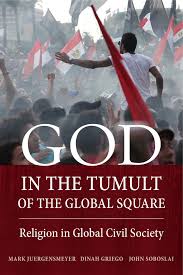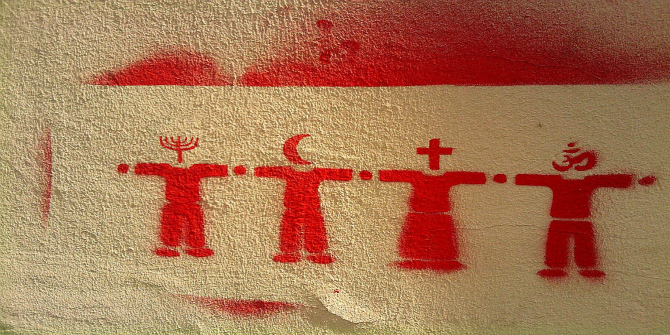Review God in the Tumult of the Global Square
In God in the Tumult of the Global Foursquare: Organized religion in Global Ceremonious Guild , authors Mark Juergensmeyer, Dinah Griego and John Soboslaiexplore new forms of faith emerging in the contemporary moment, drawing upon workshops staged over five years with religious leaders, scholars and public figures in Cairo, Moscow, Delhi, Shanghai, Bueno Aires and Santa Barbara. Nagothu Naresh Kumar praises the volume's lucid mapping of the role of religion in global civil guild, only calls for more analysis of mail-secular projects.
God in the Tumult of the Global Square: Religion in Global Civil Society . Marking Juergensmeyer, Dinah Griego and John Soboslai. University of California Press. 2015.
 A filtered product of workshops and discussions spanning five years (2010-14), crisscrossing continents and written past three authors including distinguished scholar of religion Mark Juergensmeyer, God in the Tumult of the Global Square: Organized religion in Global Civil Order gives an insight into religious lives across the world.
A filtered product of workshops and discussions spanning five years (2010-14), crisscrossing continents and written past three authors including distinguished scholar of religion Mark Juergensmeyer, God in the Tumult of the Global Square: Organized religion in Global Civil Order gives an insight into religious lives across the world.
Over the last decade, much endeavour has been expended to show emphatically that religion is alive and thriving in contravention of the much-vaunted secularisation thesis of the twentieth century. A logical corollary to such a situation would be to await at how this is happening across the globe or, as the authors put it, to 'take temperature' of organized religion and its possible capacity to provide resources for global civil society. This book is a collection of insights drawn from scholars and activists across the globe, bringing many assumptions into focus, unsettling them and further complicating our understanding of religion in the contemporary moment at a global level.
With the onset of enlightenment thought, a item concept of religion was created alongside ii unlike spheres: the public and the individual. The implications of this cocky-appointed task for secularity were considerable:
If organized religion was seen as a private experience that meant that the task of providing for social morality and communal cohesion was transferred to secular society. It has been a heavy weight to acquit (23).
Though this demarcation has never been uniform across the world, a key question is what prompted religion to spring into activeness past the end of the twentieth century. The authors point to ii interrelated aspects: namely, the loss of faith in secular nationalism, which thereby swaps positions with religion, and the globalisation procedure (21). Thus, ironically, loss of organized religion was replaced by faith in religion.
With disillusionment in secular nationalism and secular apparatuses by the late twentieth century, religion provides an alternate locus of identity. In contemporary times, three areas have been impacted by this: identity, accountability and security. Amidst the erosion of boundaries and competing voices of authority and morality, organized religion acts equally a beacon and a rudder for many. In this vortex of chaos, religion can be a harbour of stability, but tin can too function as a source of further insecurity (52). Stability can as well come at a cost made manifest, according to the authors, in the stiff mixture of religion and politics.
The religion of the pre-enlightenment era was markedly different from that of the twenty-outset century, having the capacity to accommodate a plurality of identities. For the authors, the new religiosity is marked by narrowness and exclusivity, preventing information technology from filling the role of the much-harangued and rejected secular nationalism (54).
 Image Credit: Matthew Fearnley
Image Credit: Matthew Fearnley
While stating that secularism is polyvalent likewise as polysemic (22, 24), in that location is an emphatic tone throughout the book that dubs whatever bunco of organized religion and politics as unpalatable. The authors go to nifty lengths to bear witness the amicability of organized religion in a civil atmosphere at local and international levels, while strongly eschewing whatever idea of it merging with politics. Thus, post-secularism – which recognises the persistence of organized religion and provides a voice for faith at the table of politics – is not recognised and given rather brusk shrift.
While the ethical and agglutinative properties of faith are brought out, since faith besides purportedly lacks the apparatuses of the secular state to address myriad identities and groups, for the authors a truly global religion is one that espouses peace, the separation of religion from politics and eschews violence: 'In many ways, Ahmadiyya exemplifies a modern, global religion. It reaches beyond borders, preaches peace and unity, and speaks out confronting violence of whatsoever sort' (75).
The breakdown of traditional structures of religious authority has led to changing forms of religiosity (60), where people realise that at that place are many ways to be faithful without beingness wedded to institutions and structures. This infinite has too given an opportunity for tele-evangelists and new religious groups who provide meaning and continue identities anchored. According to the authors, while tele-evangelism is harmless, information technology is the overt transition of religion into politics that makes information technology a dangerous cocktail (72). Thus, a benign religion would be one that is nonpolitical and concerned only with the personal piety of the believers.
Mentioning an Al-Azhar Academy student's idea of a borough state that is grounded in religion, the authors opine: 'Clearly these protestors were searching for a middle ground between their organized religion and their desire for a modern, democratic nation' (81). Thus, for the authors, any notion of a political system taking inspiration from a religious narrative is irreconcilable with a mod democratic nation and is tantamount to a 'middle basis'. Taking annotation of the Iranian thinker Abdolkarim Soroush (94), the authors argue that religious leaders are for disentangling faith from politics, however make no mention of thinkers such as Rached Ghannouchi or the current Tunisian political system, which allows a greater office for Islam in the public sphere and does not baulk from embracing, espousing and upholding the democratic values enshrined in its constitution.
In one of the most original chapters, the authors ask in tune with the eminent sociologist of religion, Robert Bellah, if in that location is a global civil faith. The authors debate that global faith is the 'cultural expression' of global ceremonious society. Thus, for a strident global ceremonious lodge to make strides, moral commitment at the global level is required, which only faith can provide. Both therefore share a symbiotic human relationship (118, 122). Here, examples of interfaith activity are proffered to shore up the argument that global civil lodge is very much incumbent upon global organized religion which, in turn, is premised on a religious culture that interacts with the by. A compelling case is made for a cosmopolitan global civil society aided by religion.
But, once once again, for the authors post-enlightenment religion and religiosity, with their shifting nature, are well-attuned to the projection of global civil society only cannot render themselves useful for political projects. In total, God in the Tumult of the Global Square brims with insights on every other page. It shows how global ceremonious society grounded in shareable religious culture is feasible, combining voices from beyond the globe. It brilliantly maps the cultural lives of organized religion across the earth with lucidity, merely falls short of offering the aforementioned kind of analysis to post-secular projects.
Nagothu Naresh Kumar is a graduate student at Fundamental European Academy, Budapest. His enquiry interests include religion and global politics, intellectual history and anthropology of faith. He is also a contributing scholar at State of Formation.
Note: This review gives the views of the author, and not the position of the LSE Review of Books blog, or of the London School of Economics.

Source: https://blogs.lse.ac.uk/lsereviewofbooks/2016/02/04/book-review-god-in-the-tumult-of-the-global-square-religion-in-global-civil-society-by-mark-juergensmeyer-dinah-griego-and-john-soboslai/
0 Response to "Review God in the Tumult of the Global Square"
Post a Comment